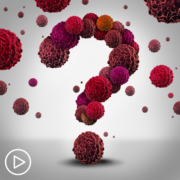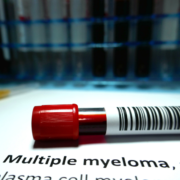Will CAR T-Cell Therapy Be Approved for Earlier Lines of Myeloma Treatment?
Will CAR T-Cell Therapy Be Approved for Earlier Lines of Myeloma Treatment? from Patient Empowerment Network on Vimeo.
Is there an opportunity for myeloma patients to gain access to CAR T-cell therapy sooner? Dr. Krina Patel discusses the results of clinical studies for CAR T-cell therapy and the potential for patients receiving the treatment earlier in their myeloma journey.
Dr. Krina Patel is an Associate Professor in the Department of Lymphoma/Myeloma at The University of Texas MD Anderson Cancer Center in Houston, Texas. Dr. Patel is involved in research and cares for patients with multiple myeloma.
Related Resources:

How Can Myeloma Patients Access CAR T-Cell Therapy Clinical Trials? |

|

|
Transcript:
Katherine:
Dr. Patel, current CAR T-cell therapy is FDA approved for patients who have had several lines of treatment.
But we know that there are a number of trials that are exploring this treatment in earlier lines. So, what is the progress on these trials?
Dr. Krina Patel:
Yeah. So, I think we have two major ones that have already been done and we’ve heard the results from. So, CARTITUDE-4 was for cilta-cel in second to fourth-line; so, patients who have relapsed once, all the way up to three times.
And then, KarMMa-3, which is ide-cel, which was one line later. So, that was third-line to fifth-lines; so, relapsed twice to four times. So, little bit different patient populations in the two trials. The trials were different in that patients had different therapies before too.
But both were positive studies which was what was really exciting. So, in CARTITUDE-4 patients were randomized, meaning they got either the CAR T or they got a standard of care option. And the CAR T won by a lot. This was, we call, hazard ratios.
But basically, the amount of different of patients surviving when they got CAR T without myeloma versus the standard of care was one of the biggest differences we’ve ever seen in a clinical trial for multiple myeloma. So, it’s –
Katherine:
Wow.
Dr. Krina Patel:
– something really pretty amazing. And then, KarMMa-3, that trial, same thing. There’s a huge difference in the patients who got CAR T versus the standard of care. The standard of care options were different in the two trials for the most part. So, again, different patient populations and different standard of care options, but the other big thing that the KarMMa-3 study did was they allowed for patients who are on the standard of care that, once they were relapsing, they could get the CAR T.
And so, because we have this crossover the big controversial thing that came up was, “Well, patients aren’t necessarily living longer by getting CAR T earlier. As long as they get CAR T they do really well.” And so, that is why there was a big meeting with the FDA what we call the ODAC meeting.
So, they had both companies present their trials to the FDA and to this advisory board that they had called ODAC, and thankfully it was positive. So, both studies were positive in terms of the advisory board saying that they agreed these should be moved up forward.
So, now we’re just waiting and hoping the FDA approves them so that we can actually give it to patients. I think the biggest reason is access. So, we know that when patients are fifth-line, which is when it’s approved now, not everybody makes it to fifth-line. It’s really hard to get through all these therapies and then still be healthy enough to do this versus if it’s approved in second and third-line, that just means so many people can actually get these therapies and available to them.
And the other big thing is the quality-of-life piece for CAR T. It’s been such a big difference when patients get a break from therapy for a year or two years or longer compared to being on continuous therapy. And so, both studies have had quality of life studies come out as well showing that difference between the standard of care versus the CAR T.










